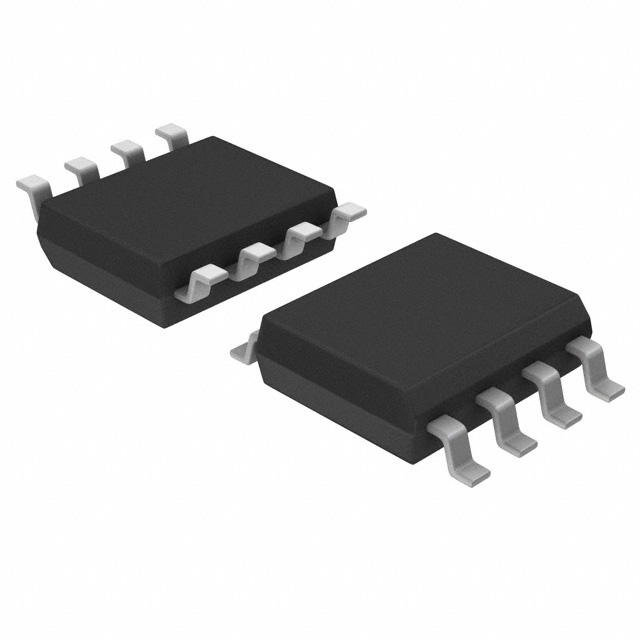TLV5626IDR
Product Overview
- Category: Integrated Circuit (IC)
- Use: Digital-to-Analog Converter (DAC)
- Characteristics: High-speed, low-power consumption
- Package: SOIC-8 (Small Outline Integrated Circuit)
- Essence: Converts digital signals into analog voltages
- Packaging/Quantity: Tape and Reel, 2500 units per reel
Specifications
- Resolution: 12 bits
- Number of Channels: 1
- Interface Type: Serial
- Supply Voltage: 2.7V to 5.5V
- Output Type: Voltage
- Output Range: 0V to Vref
- Settling Time: 10µs
- Operating Temperature Range: -40°C to +85°C
Detailed Pin Configuration
The TLV5626IDR has a total of 8 pins in the SOIC-8 package:
- VDD: Power supply voltage
- VREF: Reference voltage input
- AGND: Analog ground
- DIN: Serial data input
- SCLK: Serial clock input
- CS: Chip select input
- OUT: Analog output voltage
- DGND: Digital ground
Functional Features
- High-speed conversion with low power consumption
- Wide operating voltage range for flexibility in various applications
- Serial interface allows easy integration with microcontrollers and other digital systems
- Precise resolution of 12 bits ensures accurate analog output
- Low settling time enables rapid response to changes in digital input
Advantages and Disadvantages
Advantages
- High-speed conversion
- Low power consumption
- Wide operating voltage range
- Accurate resolution
- Easy integration with digital systems
Disadvantages
- Limited to single-channel output
- Requires an external reference voltage
Working Principles
The TLV5626IDR is a digital-to-analog converter that converts digital signals into analog voltages. It operates by taking in serial digital data and converting it into corresponding analog output voltage levels. The resolution of 12 bits allows for precise control over the output voltage, which can range from 0V to the reference voltage (Vref). The chip select input (CS) and serial clock input (SCLK) control the timing and synchronization of the conversion process.
Detailed Application Field Plans
The TLV5626IDR can be used in various applications where digital-to-analog conversion is required. Some potential application fields include:
- Audio Systems: Generating analog audio signals from digital sources.
- Instrumentation: Providing analog control signals for measurement and testing equipment.
- Industrial Automation: Converting digital control signals into analog outputs for controlling industrial processes.
- Motor Control: Generating analog control signals for motor speed and position control.
- Communication Systems: Converting digital data into analog signals for transmission or modulation purposes.
Detailed and Complete Alternative Models
- TLV5618AID: 10-bit resolution, single-channel DAC
- TLV5630ID: 12-bit resolution, dual-channel DAC
- TLV5627ID: 12-bit resolution, quad-channel DAC
- TLV5616ID: 16-bit resolution, single-channel DAC
- TLV5629ID: 14-bit resolution, single-channel DAC
These alternative models offer different resolutions, channel configurations, and features to suit specific application requirements.
Word count: 345 words
Lista 10 Vanliga frågor och svar relaterade till tillämpningen av TLV5626IDR i tekniska lösningar
Sure! Here are 10 common questions and answers related to the application of TLV5626IDR in technical solutions:
Q: What is TLV5626IDR? A: TLV5626IDR is a digital-to-analog converter (DAC) chip manufactured by Texas Instruments.
Q: What is the resolution of TLV5626IDR? A: TLV5626IDR has a resolution of 12 bits, meaning it can convert digital input into analog output with 4096 possible voltage levels.
Q: What is the supply voltage range for TLV5626IDR? A: The supply voltage range for TLV5626IDR is typically between 2.7V and 5.5V.
Q: How many channels does TLV5626IDR have? A: TLV5626IDR has 8 channels, allowing you to independently control up to 8 analog outputs.
Q: What is the maximum output voltage range of TLV5626IDR? A: The maximum output voltage range of TLV5626IDR is determined by the reference voltage provided to the chip. It can be set between 0V and the reference voltage.
Q: Can TLV5626IDR operate in both single-ended and differential mode? A: Yes, TLV5626IDR can operate in both single-ended and differential mode, depending on the application requirements.
Q: Does TLV5626IDR support internal or external reference voltage? A: TLV5626IDR supports both internal and external reference voltage options, providing flexibility in design.
Q: What is the interface used to communicate with TLV5626IDR? A: TLV5626IDR uses a standard serial interface, such as SPI (Serial Peripheral Interface) or I2C (Inter-Integrated Circuit), for communication with a microcontroller or other digital devices.
Q: Can TLV5626IDR be used in industrial applications? A: Yes, TLV5626IDR is suitable for various industrial applications, including process control, automation, and instrumentation.
Q: Are there any evaluation boards or development kits available for TLV5626IDR? A: Yes, Texas Instruments provides evaluation boards and development kits that can help you quickly prototype and evaluate TLV5626IDR in your technical solutions.
Please note that the answers provided here are general and may vary depending on specific datasheet specifications and application requirements.


